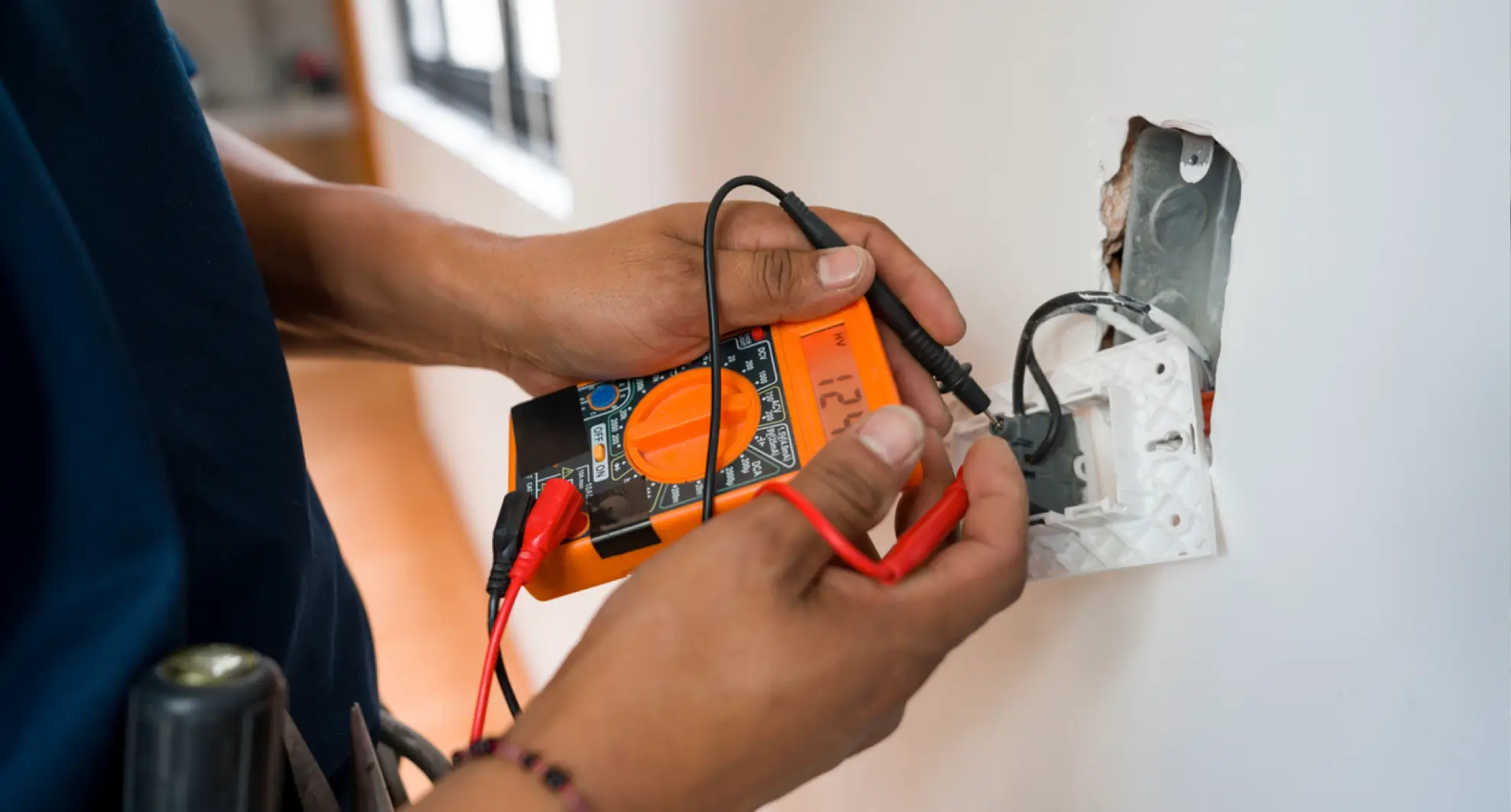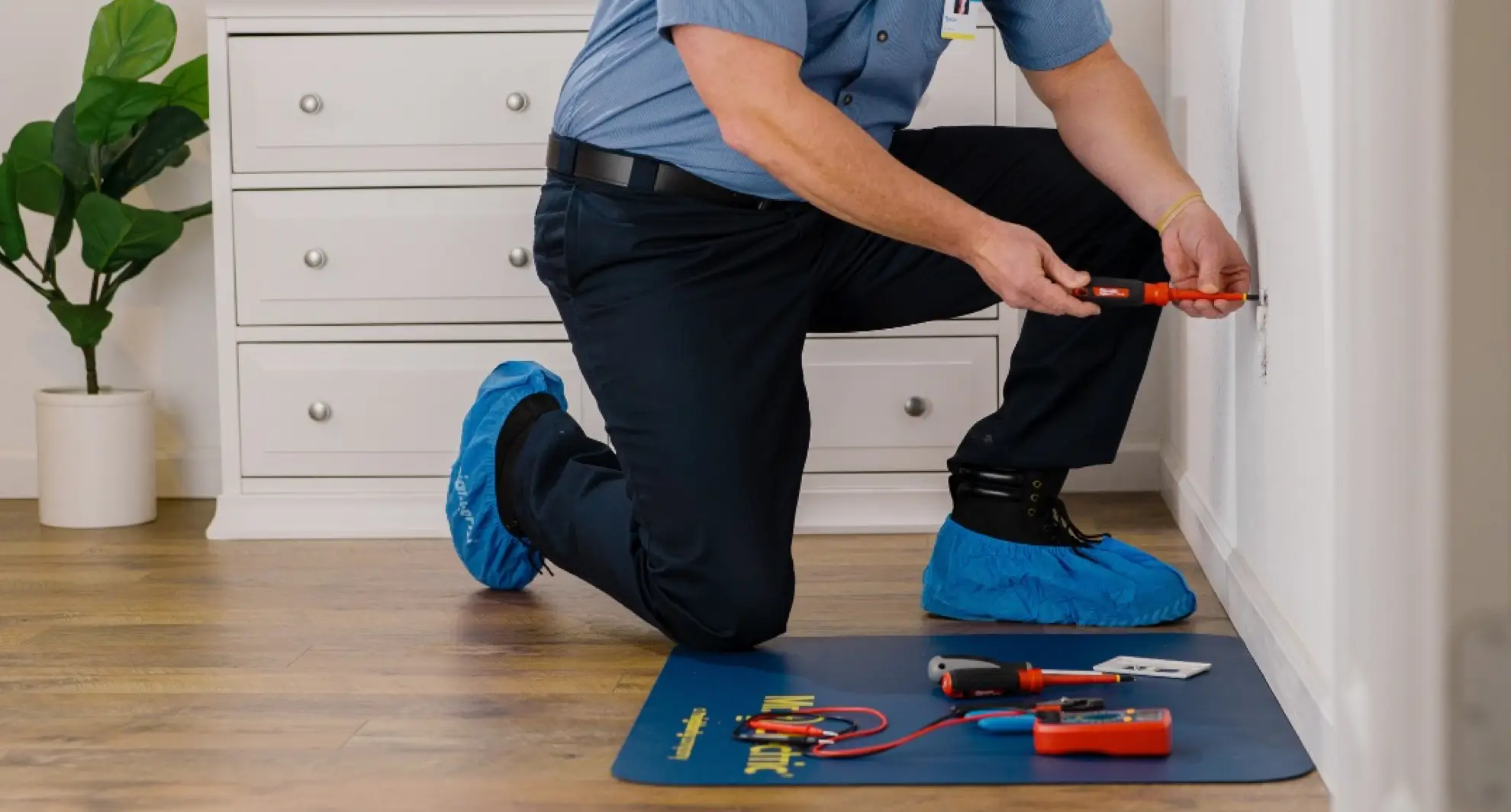
Need to troubleshoot a dead outlet? Then you need a multimeter. This helpful device can help you test outlets, cords, light strands, bulbs, and more by measuring the flow of electricity. You can use it to determine if an outlet is dead or experiencing an unexpected issue while still delivering electricity.
Not sure how to test an outlet? We’ll show you how to test an outlet with a multimeter and explain the other functions of this helpful tool.
What Can a Multimeter Tell You About Outlets?
Multimeters are electrical current measurement devices that can help you understand the resistance, current, and voltage of circuits, such as those in outlets, by injecting a small charge into them. The charge is then measured on its way back to the multimeter to diagnose various issues inside the circuits.
When you're testing an outlet with a multimeter, it can help you determine:
- If power is reaching an outlet
- If the outlet is properly grounded
- Whether wiring within the outlet is reversed
This tool measures three different electrical values: voltage, amps, and ohms. By learning how to read these outputs effectively, you can determine whether your outlet is functional. If it is broken, multimeter readings can show you what has rendered it nonfunctional.
When You Should Test an Outlet
Not every outlet issue is obvious. Sometimes it's a dead plug, other times it's something more subtle, like weird behavior from a device that works fine everywhere else. If you're seeing (or smelling) any of the signs below, it's time to grab a multimeter—or call your local Mr. Electric® for professional assistance.
1. The outlet has stopped working entirely
If nothing powers on and you've already ruled out tripped breakers or GFCIs, you're looking at a dead outlet. Testing can confirm if the issue is with the outlet itself or somewhere further up the line.
2. Devices spark or shock when plugged in
Even a tiny zap isn't normal. It could be a sign of reversed polarity, a grounding issue, or loose wiring behind the plate, all things a multimeter can help identify quickly.
3. Electronics behave unpredictably
If your lamp flickers, your charger gets hot, or your devices power on and off without warning, the outlet might be feeding inconsistent or incorrect voltage.
4. The outlet is warm to the touch
A little warmth from heavy use is one thing. But if the faceplate is noticeably hot, it's time to stop using that outlet until it's tested. Heat could mean loose connections or overloaded wiring.
5. You smell burning or see discoloration
Charred edges, burn marks, or a faint burning smell are all serious red flags. Power down that outlet immediately and have it tested. In most cases, it'll need to be replaced before it causes more damage.
6. You're adding or upgrading major appliances
Before installing anything that draws serious power, like a new fridge, washer, or A/C unit, you'll want to confirm the outlet is wired correctly and can handle the load. A multimeter can help verify voltage and grounding before you plug in.

How to Test an Outlet with a Multimeter in 6 Simple Steps
Multimeters are widely available and inexpensive tools, but if you don’t know how to read them, you won’t get much out of them. Here’s a six-step guide detailing how to test an outlet with a multimeter:
- Learn the essentials of outlet testing safety. Because you must perform these tests on a live outlet, ensure your safety by holding both meter probes in the same hand. This will help prevent shock from passing through your body. It’s also a good idea to wear rubber gloves as a precaution in case you lose your grip on the meter probes. Never allow the metal portion of the probes to brush each other or touch, as this can create a dangerous short circuit.
- Get to know outlet geography. Modern outlets have three slots: one for hot, one for neutral, and one for ground. The rounded half circle is the ground, the longer slot (left) is the neutral, and the shorter slot (right) is hot. Remember that all the wires can carry current, so handle them cautiously.
- Adjust your multimeter. Set your meter to measure voltage. Select the alternating current (AC) function on the multimeter, which is often labeled with a wavy line. The direct current (DC) function will have a solid line and a dashed line.
- Measure the voltage to determine if the outlet has power. Using one hand, insert a probe into each vertical slot on the outlet. Red goes into the smaller slot, and black goes into the larger one. A properly functioning outlet will give a reading of 110–120 volts. If there is no reading, either something is wrong with the wiring in the outlet or the circuit breaker is tripped. If the outlet is connected to a light switch, make sure the outlet is on.
- Determine if the outlet is properly grounded. Keep the red lead in the small slot and place the black lead in the ground (U-shaped) outlet slot. The reading should remain the same. If it doesn’t, the outlet is improperly grounded.
- Check if the wiring is reversed. Place the red lead into the large slot and the black lead into the small slot. If you get a reading, the wiring is reversed. This won’t affect simple equipment like lamps but can cause issues for more sophisticated appliances and electronics.
Why DIY Electrical Testing Isn't Always Worth the Risk
Knowing how to check an outlet with a multimeter is one thing; doing so safely is another. Testing an outlet with a multimeter might seem simple. It's just two probes and a digital readout, right? But once you start testing live outlets, you're not just poking around in plastic; you're working with live voltage that can cause serious injury or worse if handled incorrectly.
Here's why it pays to know your limits:
You're working with live electricity
To test an outlet properly, it has to be energized. That means one wrong move—like touching both probes at once or letting a finger slip—and you complete a circuit through your body. Even standard 120 volts is more than enough to cause harm.
Misuse of the multimeter can cause shorts or sparks
Set the multimeter to the wrong function (like amperage instead of voltage), and you could trip the breaker or create a flash of heat that damages the outlet, your device, or you. Using the wrong test method is a common mistake, especially with combo-function meters.
Damaged or loose wires aren't always visible
Even if everything looks fine on the surface, one loose connection or exposed wire behind the wall can create a hidden hazard. If you're not trained to recognize warning signs or not equipped to handle what you find, you may leave the problem worse than you found it.
You could misdiagnose the issue
Low voltage? Bad wiring? Backstabbed outlet? The symptoms of different electrical problems can overlap. Misinterpreting what your multimeter is telling you can lead to unsafe repairs, unnecessary replacements, or both.
There's more at stake than the outlet
One mistake doesn't just affect that one plug. Electrical problems can cascade, causing damage to circuits, appliances, or your home's panel. Worse, a poorly handled test or repair could set the stage for fire hazards.
Bottom line: If you're confident, cautious, and know your way around a multimeter, basic testing is fine. But if anything feels unclear or if you're unsure what the results mean, call your local Mr. Electric. We'll troubleshoot the issue, explain what's going on, and get your system back on track.
Count on Mr. Electric for Safe, Prompt Electrical Service
Need to resolve your outlet issue? Avoid a hair-raising electrical experience. Your local Mr. Electric will be happy to help with any electrical projects you’ve been putting off. Whether you need to replace an existing outlet, install a new outlet, or upgrade to a GFCI outlet, our experts can handle your needs. Plus, we back all our work with the Neighborly Done Right Promise® to ensure your satisfaction. Contact Mr. Electric today to schedule an appointment online.
This article is intended for general guidance only and is not applicable to every situation. You are responsible for determining the proper course of action for your property and situation. Mr. Electric is not responsible for any damages that occur as a result of advice and/or guidance derived from its blog content.
Some Mr. Electric services vary by location. Contact your local Mr. Electric franchise for more information.
FAQs About Testing an Outlet with a Multimeter
The safety of you, your family, and home are the top priority of every Mr. Electric service professional. Our safety-first commitment to solving your electrical issues includes a meticulous attention to detail on every job. Our commitment also includes using our years of experience to answer your questions. Below are answers to some of the most frequently asked questions about testing an outlet with a multimeter.
Can a multimeter tell me if an outlet is safe to use?
Yes, but only to a point. A multimeter can confirm correct voltage, grounding, and polarity, which are basic indicators of safety. However, it won't catch deeper issues like worn insulation, hidden arcing, or aging components. If you're unsure, your local electrician can assess your outlet.
What does it mean if my outlet reads zero volts?
It typically means the outlet isn't receiving power. This could be caused by a loose wire, a tripped breaker, or a failed connection somewhere upstream. If resetting the breaker doesn't help, further testing is needed, and it's probably time to call in a professional.
Can I test an outlet without removing the cover plate?
Yes. Most standard testing is done by inserting the multimeter probes directly into the outlet slots, no disassembly required. Removing the cover plate is only necessary if you're checking internal wiring or replacing the outlet.

